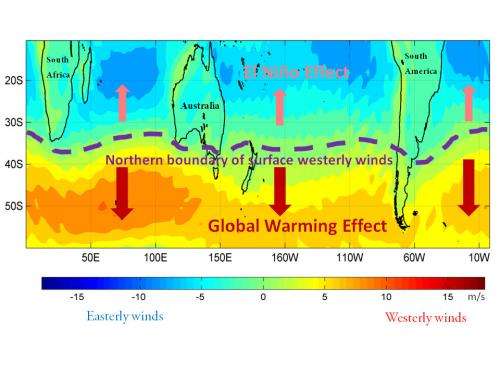Climate tug of war disrupting Australian atmospheric circulation patterns

(Phys.org) —The study, in the Nature journal Scientific Reports, demonstrates that mid-latitude high pressure zones (30 S-45 S) are being pushed further into the Southern Ocean by rising global temperatures associated with greenhouse warming. This is despite more frequent occurrences of strong El Niños in recent decades, which should have drawn the high pressure zones in the opposite direction toward the equator.
"What we are seeing," says study lead author, Mr Guojian Wang "is a 'tug of war' between stronger El Niños driving the winds north and the greenhouse gas-warming effect driving the winds south".
Mr Wang, said the result confirms the robustness of the Southern Hemisphere circulation changes over the past three to four decades as the global temperature rose, "so much so that it overode the influence from strong El Niños during this period."
Study co-author, Dr Wenju Cai said the most conspicuous change is a rising sea level pressure in the mid-latitude bands and a decreasing sea level pressure over the Southern high latitudes (55-70 S), a pattern referred to as the Southern Annular Mode. The changing pressures indicate a poleward or southward expansion of the tropical and subtropical atmospheric zones.
In turn, this indicates that over the long-term, there is a relationship between a rising global mean temperature and an upward trend of the Southern Annular Mode.
"The research reinforces our past work that climate change is altering Southern Hemisphere circulation and increases our confidence in this conclusion," Dr Cai said.
Dr Cai has previously reported on changes in atmospheric circulation that have been shifting and strengthening the Pacific Ocean winds poleward and in turn strengthening the ocean circulation, pushing the East Australian Current further south down the Australian coast.
He said during El Niño, the warmer ocean releases heat to the atmosphere and global average temperatures increase. At the same time, warm ocean surface temperatures along the equator cause the tropical and subtropical atmospheric belts to move toward the equator, generating a 'negative' phase of the Southern Annular Mode.
"On year-to-year time scales, higher global temperatures are associated with a negative phase of the Mode but over the past 35 years, when El Niño has been strong and conducive to a negative trend, we are seeing an opposite trend with the circulation systems moving southward impacting on regional climate," he said.
Journal information: Scientific Reports
Provided by CSIRO















